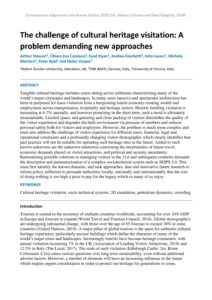| Document | Author Arthur Stewart, Chiara Eva Catalano, Eyad Elyan, Andrea Giachetti, John Isaacs, Michela Mortara, Peter Reid and Helen Vosper |
| Abstract Tangible cultural heritage includes assets dating across millennia characterising many of the world’s major cityscapes and landscapes. In many cases massive and spectacular architecture has been re-purposed for mass-visitation from a burgeoning tourist economy creating wealth and employment across transportation, hospitality and heritage sectors. Historic building visitation is increasing at 6-7% annually, and however promising in the short term, such a trend is ultimately unsustainable. Limited space, and queueing and close packing of visitors diminishes the quality of the visitor experience and degrades the built environment via pressure of numbers and reduces personal safety both for visitors and employees. However, the problem is much more complex and must also address the challenge of visitor experience for different users, financial, legal and operational constraints and a profoundly changing visitor-demographic which clearly identifies that past practice will not be suitable for operating such heritage sites in the future. Added to such known unknowns are the unknown unknowns concerning the uncertainties of future travel, economic demands placed on visitor attractions, and political and security uncertainty. Rationalising possible solutions to managing visitors in the 21st and subsequent centuries demands the description and parameterisation of a complex-sociotechnical system such as SEIPS 2.0. This must first identify the known domains, and seek approaches, data and innovative future research to inform policy sufficient to persuade authorities locally, nationally and internationally that the cost of doing nothing is too high a price to pay for the legacy which so many of us enjoy. |

